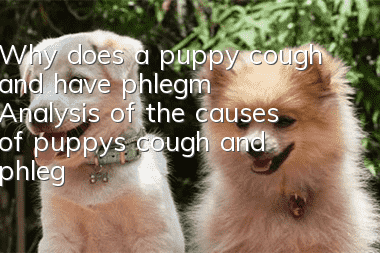There are a few drops of blood after a dog poops. What causes blood in a dog’s poop?

A few drops of blood after a dog poops may be caused by constipation
Constipation is a relatively common situation. Bleeding caused by constipation usually appears after elimination. A layer of blood outside the stool is caused by hemorrhoid bleeding caused by constipation.
The causes of constipation in dogs include sudden changes in the living environment, resulting in emotional stress and constipation; there are also constipation caused by not going out to exercise, being obese and too lazy to exercise; and there are also common foods. The meals are all meat, the dietary fiber is not absorbed enough, and the water is drank too little, resulting in constipation; constipation may also be caused by swallowing indigestible food.
Dog constipation can be alleviated by improving the dog’s diet structure. Do not let the dog eat too much liver, bones, etc., and also ensure the dog’s water intake. Let the dog have an appropriate amount of exercise, maintain a certain amount of exercise every day, pay attention to weight changes, and do not let the dog become a part of obesity. If you suffer from constipation, you can also feed your dog some probiotics and health products that promote digestion to enhance your dog’s digestive ability and protect their stomach.
There may be a few drops of blood in the dog's stool after eating bones
After the dog eats chicken, duck and other bones, the dog may have bright red blood in the stool. At this time Bloodshot blood is caused by bleeding caused by acute gastroenteritis caused by bones scratching the intestines and stomach in the small intestine or bones getting stuck in the intestines and stomach.
Acute gastroenteritis in dogs is generally caused by improper feeding. Even if the dog eats something that is too cold, putrid, and difficult to digest, gastrointestinal damage caused by the bones of small poultry such as chickens and ducks can also cause gastroenteritis. Specific symptoms include poor energy, loss of appetite, diarrhea, vomiting, severe dehydration, etc. If the blood in the stool is bright red, it means bleeding in the posterior gastrointestinal segment, and if it is tar-colored, it means bleeding in the stomach.
Generally speaking, mild gastroenteritis can heal on its own. For the treatment of gastroenteritis, you should first cleanse the intestines and stomach, use neutral salt laxatives to accelerate the elimination of objects in the intestines and stomach, and then use compound gentian tincture, Artificial salt is used to enhance appetite and promote gastrointestinal motility. Or feed anti-inflammatory medicine, break it up and inject it into the dog’s mouth with a syringe, and let it swallow it. If the stomach is scratched, the dog can take Yunnan Baiyao powder to heal the wound. During the recovery period, adjust the diet to be light, easy to absorb and digest.
A few drops of blood after the dog poops may be caused by parvovirus
Parvovirus is most likely to appear in vaccinated puppies, and it is a major serious infection that harms dogs. One of the diseases. The virus mainly attacks two types of cells, intestinal epithelial cells and cardiomyocytes, causing gastrointestinal symptoms and myocarditis respectively.
From the perspective of defecation, Xiaoxiao mainly presents with sticky stool, similar to tomato paste, accompanied by severe vomiting. In addition, depression, anorexia, fever, vomiting and dehydration may occur. In enteritis caused by parvovirus, the vomitus will contain food, gastric juice, and yellow-green bile, and the diarrhea will mainly contain water, which has an unusual fishy odor.
If minor symptoms occur, it is recommended to go directly to the doctor for treatment. Do not delay the condition. Self-administering medicine is unprofessional and will have the opposite effect.
A few drops of blood after a dog’s stool may be due to parasites
Canine coccidiosis is also one of the factors that cause blood in the dog’s stool. Causes mucohemorrhagic inflammation of the large intestine and small intestine. Jelly-like intestinal mucosa can be seen in the stool, and the stool appears brown.
Symptoms caused by canine coccidiosis virus will include mild fever, loss of appetite, indigestion, diarrhea, thin stool mixed with mucus or jelly-like intestinal mucosa. Severe cases may include bloody stools, brown stools, rapid weight loss, anemia, and dehydration.
Canine coccidiosis virus can be treated by taking sulfamethoxazine 100mg/kg body weight orally, 2-3 times a day, for 3-5 days; sulfamethoxazine 60mg/kg body weight, orally, 3 times a day. Take it continuously for 3-4 days; Furasetrin, 10mg/kg body weight, orally, 2 times/day, take it continuously for 3-5 days. In addition to taking medication, the kennel and living environment must be disinfected regularly. If you do not understand the pharmacological advice, it is best for your pet to send it to a pet hospital as soon as possible.
Random articles
- How to care for your dog after he is cured of parvo. How to care for your dog after he is cured of parvo.
- Is it impure if Corgi's ears are not erect? How to help Corgi erect ears?
- What to do if your Pomeranian dog has diarrhea What to do if your Pomeranian dog has diarrhea
- How to deal with parasites in otter hunting dogs? How to prevent parasites in otter hunting dogs?
- Your dog’s stomach is growling. Pay attention to your dog’s physical condition.
- Does Bichon Frize like to bark? Why does Bichon Frize like to bark?
- What should I do if my dog vomits? What medicine should I take? Why do dogs vomit frequently?
- The difference between Corgi and Shiba Inu: one relies on the face and the other relies on the butt to eat
- How to deal with vomiting in an otter dog How to deal with vomiting in an otter dog
- Can Pomeranian dogs eat bananas? What are the effects of eating bananas on dogs?



